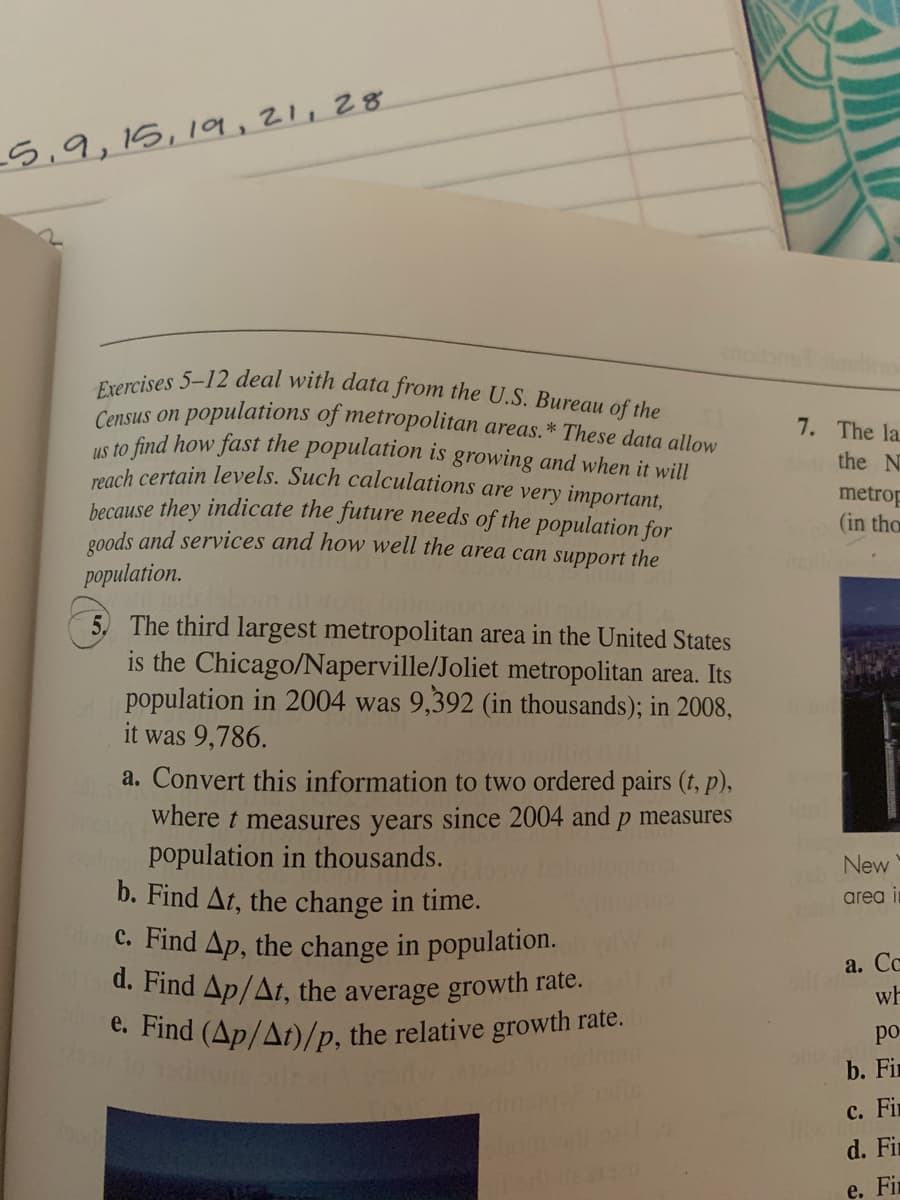The third largest metropolitan area in the United States is the Chicago/Naperville/Joliet metropolitan area. Its population in 2004 was 9,392 (in thousands); in 2008, t was 9,786. 1. Convert this information to two ordered pairs (t, p), where t measures years since 2004 and p measures population in thousands. · Find At, the change in time. Find Ap, the change in population. Find Ap/At, the average growth rate. Find (Ap/At)/p, the relative growth rate.
The third largest metropolitan area in the United States is the Chicago/Naperville/Joliet metropolitan area. Its population in 2004 was 9,392 (in thousands); in 2008, t was 9,786. 1. Convert this information to two ordered pairs (t, p), where t measures years since 2004 and p measures population in thousands. · Find At, the change in time. Find Ap, the change in population. Find Ap/At, the average growth rate. Find (Ap/At)/p, the relative growth rate.
Algebra & Trigonometry with Analytic Geometry
13th Edition
ISBN:9781133382119
Author:Swokowski
Publisher:Swokowski
Chapter5: Inverse, Exponential, And Logarithmic Functions
Section: Chapter Questions
Problem 6DE
Related questions
Concept explainers
Equations and Inequations
Equations and inequalities describe the relationship between two mathematical expressions.
Linear Functions
A linear function can just be a constant, or it can be the constant multiplied with the variable like x or y. If the variables are of the form, x2, x1/2 or y2 it is not linear. The exponent over the variables should always be 1.
Question

Transcribed Image Text:e. Find (Ap/At)/p, the relative growth rate.
d. Find Ap/At, the average growth rate.
Exercises 5-12 deal with data from the U.S. Bureau of the
Census on populations of metropolitan areas. * These data allow
5,9,15,10, 21,28
7. The la
us to find how fast the population is growing and when it will
ach certain levels. Such calculations are very important,
because they indicate the future needs of the population for
0oods and services and how well the area can support the
the N
metrop
(in tho
population.
5, The third largest metropolitan area in the United States
is the Chicago/Naperville/Joliet metropolitan area. Its
population in 2004 was 9,392 (in thousands); in 2008,
it was 9,786.
a. Convert this information to two ordered pairs (t, p),
where t measures years since 2004 and p measures
population in thousands.
New
b. Find At, the change in time.
C. Find Ap, the change in population.
2 area i
а. Сс
wh
po
b. Fin
с. Fi
d. Fir
e. Fin
Expert Solution
This question has been solved!
Explore an expertly crafted, step-by-step solution for a thorough understanding of key concepts.
This is a popular solution!
Trending now
This is a popular solution!
Step by step
Solved in 2 steps with 6 images

Knowledge Booster
Learn more about
Need a deep-dive on the concept behind this application? Look no further. Learn more about this topic, advanced-math and related others by exploring similar questions and additional content below.Recommended textbooks for you

Algebra & Trigonometry with Analytic Geometry
Algebra
ISBN:
9781133382119
Author:
Swokowski
Publisher:
Cengage


Linear Algebra: A Modern Introduction
Algebra
ISBN:
9781285463247
Author:
David Poole
Publisher:
Cengage Learning

Algebra & Trigonometry with Analytic Geometry
Algebra
ISBN:
9781133382119
Author:
Swokowski
Publisher:
Cengage


Linear Algebra: A Modern Introduction
Algebra
ISBN:
9781285463247
Author:
David Poole
Publisher:
Cengage Learning

College Algebra (MindTap Course List)
Algebra
ISBN:
9781305652231
Author:
R. David Gustafson, Jeff Hughes
Publisher:
Cengage Learning

Big Ideas Math A Bridge To Success Algebra 1: Stu…
Algebra
ISBN:
9781680331141
Author:
HOUGHTON MIFFLIN HARCOURT
Publisher:
Houghton Mifflin Harcourt

Trigonometry (MindTap Course List)
Trigonometry
ISBN:
9781337278461
Author:
Ron Larson
Publisher:
Cengage Learning